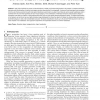Free Online Productivity Tools
i2Speak
i2Symbol
i2OCR
iTex2Img
iWeb2Print
iWeb2Shot
i2Type
iPdf2Split
iPdf2Merge
i2Bopomofo
i2Arabic
i2Style
i2Image
i2PDF
iLatex2Rtf
Sci2ools
PAMI
2006
2006
Generic Object Recognition with Boosting
This paper explores the power and the limitations of weakly supervised categorization. We present a complete framework that starts with the extraction of various local regions of either discontinuity or homogeneity. A variety of local descriptors can be applied to form a set of feature vectors for each local region. Boosting is used to learn a subset of such feature vectors (weak hypotheses) and to combine them into one final hypothesis for each visual category. This combination of individual extractors and descriptors leads to recognition rates that are superior to other approaches which use only one specific extractor/descriptor setting. To explore the limitation of our system, we had to set up new, highly complex image databases that show the objects of interest at varying scales and poses, in cluttered background, and under considerable occlusion. We obtain classification results up to 81 percent ROC-equal error rate on the most complex of our databases. Our approach outperforms al...
| Added | 14 Dec 2010 |
| Updated | 14 Dec 2010 |
| Type | Journal |
| Year | 2006 |
| Where | PAMI |
| Authors | Andreas Opelt, Axel Pinz, Michael Fussenegger, Peter Auer |
Comments (0)

